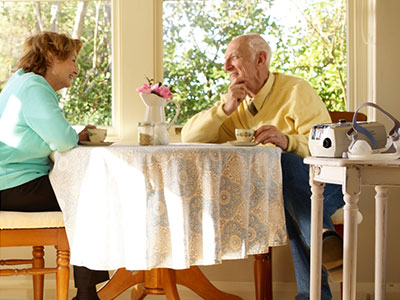Obesity hypoventilation syndrome (OHS)
Learn more about OHS symptoms and treatment options.
What is obesity hypoventilation syndrome (OHS)?
As the name suggests, OHS usually affects people who are overweight or obese.
Hypoventilation means that breathing is too shallow or too slow. Because your body needs to work harder to breathe, your respiratory system becomes exhausted and you could end up with carbon dioxide levels that are too high and oxygen levels that are too low. A doctor or clinic can easily diagnose this with an arterial blood gas analysis.
If you have OHS you might be experiencing:
- shortness of breath
- excessive daytime sleepiness (EDS)
- morning headaches
- depression
Why is it important to treat OHS?
Not being able to breathe deeply enough can affect your ability to take part in activities you love and places a lot of strain on your organs.
Left untreated, OHS often results in:
- heart failure on the right side of the heart1
- pulmonary hypertension (where the blood pressure in the arteries that carry blood from the heart to the lungs is higher than normal)1
- polyglobulia (where there is an abnormal increase in the number of circulating red blood cells. Also known as polycythemia).1
OHS is a serious disorder so it’s important to find out if you have it and get it treated.
If you have obstructive sleep apnoea and you still feel sleepy during the day and have headaches, talk to your physician about being tested for OHS.
Treatment options for obesity hypoventilation syndrome
OHS can be treated effectively by following a controlled weight loss programme1 and starting positive airway pressure or non-invasive ventilation (NIV).2 Your doctor may also monitor your condition using the following:
- An arterial blood gases test*
- A lung function test
- A polysomnography test (overnight sleep study)
- Chest x-rays
- Non-invasive ventilation (NIV)
For OHS, the aim of ventilation is to improve the exchange of oxygen and carbon dioxide between the blood and the air in your lungs3 and support your respiratory system so you don’t need to work so hard to breathe effectively.4 Pressurised air is delivered from a small device that sits on your bedside table, to a mask that you wear over your mouth and/or nose. NIV is a common treatment option for OHS.2
Keep exploring

What is non-invasive & invasive ventilation therapy?
Learn how non-invasive ventilation (NIV) or invasive ventilation (IV) could help you to breathe more easily.

Respiratory diseases & conditions
Learn about other respiratory diseases such as OHS, neuromuscular and restrictive lung diseases and invasive or non-invasive ventilation treatments at home or in the hospital.

What happens during normal breathing?
To understand what could be affecting your ability to breathe properly, it’s helpful to know what normal breathing looks like.
References:
* This test measures the acidity, oxygen and carbon dioxide content of the blood in your arteries to see how well your lungs move oxygen into the blood, and carbon dioxide out of the blood.
- Parameswaran, K, Todd, DC, Soth, M . Altered respiratory physiology in obesity. Can Respir J 2006;13(4): 203-210.
- Storre JH, Seuthe B, Fiechter R, Milioglou S, Dreher M, Sorichter S, Windisch W. Average volume-assured pressure support in obesity hypoventilation: A randomised crossover trial. Chest 2006 Sep; 130(3): 815-21.
- Olson AL, Zwillich C. The obesity hypoventilation syndrome. Am J Med 2005 Sep; 118(9): 948-56.
- Nowbar S, Burkart KM, Gonzales R, Fedorowicz A, Gozansky WS, Gaudio JC, Taylor MR, Zwillich CW. Obesity-associated hypoventilation in hospitalised patients: prevalence, effects, and outcome. Am J Med 2004 Jan 1; 116(1): 1-7.